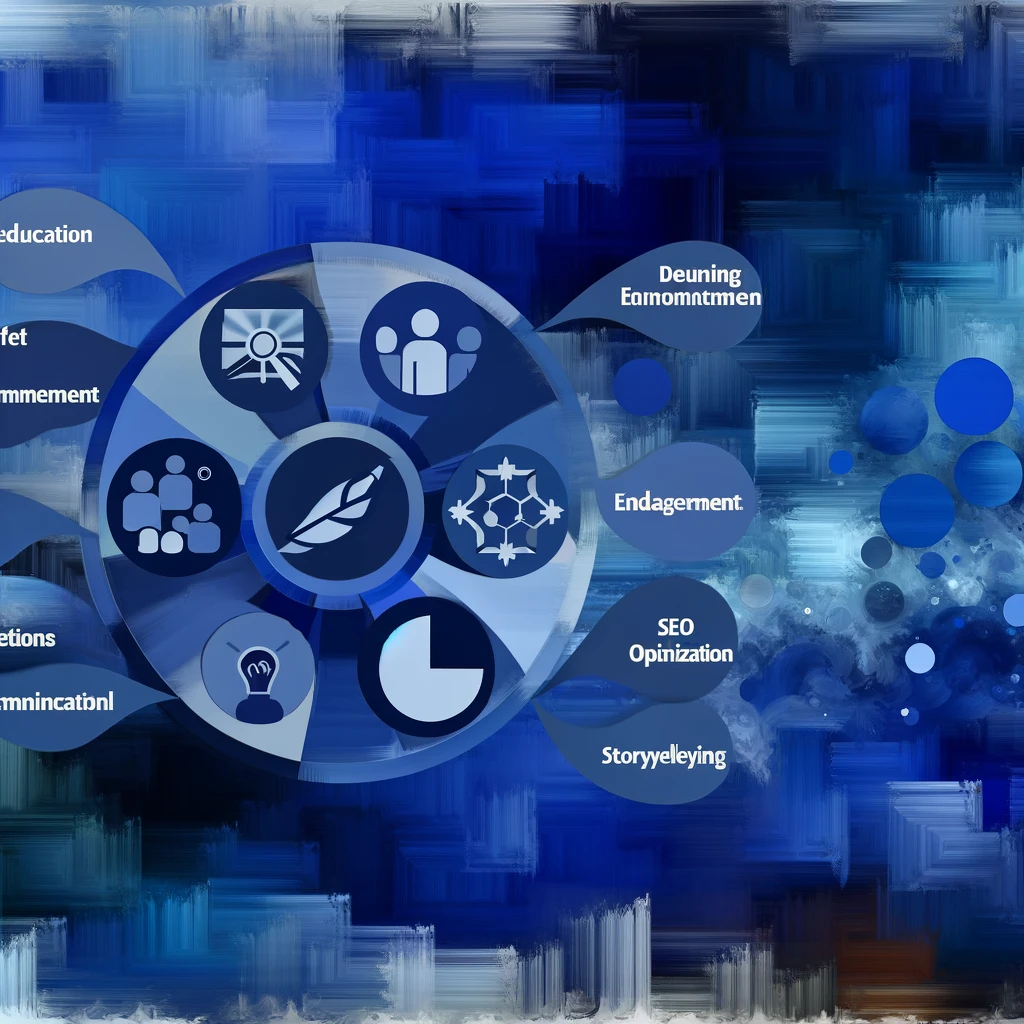
Unlocking Success: Content Marketing Strategies for Drug Rehab Centers
Table of Contents
drug rehab content marketing
Introduction
In today's digital world, standing out as a drug rehab center requires more than just a website. It's about creating content that educates, engages, and empathizes with your audience. Content marketing is your ally in this journey, helping you to not only reach your audience but connect with them on a deeper level. Let's explore how you can unlock success through strategic content marketing.
Understanding Content Marketing
In the realm of digital communication, understanding content marketing takes on a pivotal role, especially for drug rehab centers striving to make a real difference in people's lives. It transcends the mere act of content creation, venturing deep into the art of forging meaningful connections.
This intricate process involves:
- Sharing Stories That Matter: Every piece of content is an opportunity to tell a story that resonates with someone's heart and soul. For those on the path to recovery, these stories can be a source of inspiration and a beacon of hope, illuminating the way forward.
- Providing Valuable Information: Beyond storytelling, content marketing is about delivering information that empowers. For individuals and families navigating the complexities of addiction, knowledge is power. It's about offering insights into the journey of recovery, understanding addiction, and showcasing the possibilities of a life reclaimed.
- Offering Resources for Support: The content crafted by drug rehab centers should serve as a toolkit for those in need. From guides on seeking help to resources for coping strategies and maintaining sobriety, each piece of content is a stepping stone towards healing and support.
- Creating a Space of Hope: At its core, content marketing for drug rehab centers is about weaving a narrative of hope. It's about painting a picture of a future where recovery is not just possible but is within reach, encouraging those in the shadows to step into the light.
By embracing these facets, content marketing becomes more than a strategy; it transforms into a mission. It's a commitment to reaching out, touching lives, and making a meaningful difference through the power of empathy, information, and unwavering support. This is the essence of content marketing in the context of drug rehab centers, where every word can be a lifeline for someone in need. Explore in-depth insights and strategies for effective content marketing at the Content Marketing Institute.

Why Content Marketing for Drug Rehab
The journey of recovery is personal and fraught with challenges. Content marketing allows rehab centers to reach out with empathy, offering a guiding light to those in need. It's not just marketing; it's a mission of support.
The path to recovery is uniquely personal, laden with obstacles and moments of both despair and hope. Content marketing, in the context of drug rehab centers, transcends traditional marketing paradigms to become a powerful mission of support and empathy. This approach involves:
- Understanding the Individual Journey: Recognizing that each person's path to recovery is filled with unique challenges. Content marketing aims to address these diverse experiences, providing tailored support and guidance that speaks directly to the individual's journey.
- Offering Empathy at Every Step: At the heart of effective content marketing lies deep empathy. It's about creating content that reflects a profound understanding of the struggles faced by those battling addiction. This content serves as a compassionate companion, offering solace and understanding when it's needed most.
- Becoming a Guiding Light: For many, the road to recovery can seem dauntingly dark and uncertain. Content marketing shines as a beacon of hope, illuminating the way forward with stories of recovery, evidence-based treatment options, and the promise of a supportive community. This guiding light encourages individuals to take the brave steps toward healing.
- Mission-Driven Marketing: This approach redefines the purpose of marketing within the rehab sector. It's not just about promoting services; it's about a genuine mission to provide support, share knowledge, and uplift spirits. Every piece of content is crafted with the goal of making a positive impact on someone's life, offering a hand to hold on their journey to recovery.
Through content marketing, rehab centers can bridge the gap between clinical support and emotional understanding, creating a holistic environment of care. It's a testament to the power of words and stories to heal, inspire, and transform lives. This is not just marketing; it's a profound mission of empathy and support, guiding individuals towards a brighter, healthier future. Gain valuable information and resources on addiction and recovery from the National Institute on Drug Abuse.
Key Strategies for Effective Content
In the journey of crafting content that truly resonates with those seeking help from drug rehab centers, a dual approach of Creating Empathetic Content and providing Educational Content emerges as a cornerstone for meaningful engagement. This strategy not only enlightens but also nurtures the fragile bonds of trust and understanding. Here’s how it unfolds:
Creating Empathetic Content
- Dive Deep into Understanding: Begin by immersing yourself in the experiences, needs, and fears of your audience. This deep dive into their world is crucial for creating content that genuinely resonates.
- Speak from a Place of Understanding: Empathetic content is born from a profound sense of shared experience. It acknowledges the struggles, validates the emotions, and offers solace, making it a powerful tool to break down the walls of isolation and mistrust.
- Build Trust Through Compassion: By consistently delivering content that comes from a place of empathy and understanding, rehab centers can foster a trusted environment where individuals feel seen and supported.
Educational Content
- Empower with Information: Arm your audience with knowledge by providing accessible, reliable information. From detailed articles on coping mechanisms to insights into the biological underpinnings of addiction, education empowers individuals to take an active role in their recovery journey.
- Illuminate the Path with Science: Demystifying the science of addiction and recovery can illuminate the path forward, offering hope and clarity. When people understand the ‘why’ and ‘how’ of their experiences, they are better equipped to navigate the complexities of recovery.
- Encourage with Real-Life Applications: Blend theoretical knowledge with practical advice. Share strategies for managing cravings, tips for rebuilding relationships, and guidance on maintaining a healthy lifestyle post-recovery.
By intertwining empathetic and educational content, drug rehab centers can create a powerful narrative that not only informs but also heals. This approach transcends traditional content marketing, offering a beacon of hope and a steady hand to those on the difficult path to recovery. It’s about creating a space where knowledge meets understanding, and where each piece of content serves as a stepping stone towards a brighter, healthier future. Learn essential strategies and tips for effective content marketing planning at CoSchedule.

Crafting Your Content Plan
Crafting Your Content Plan for a drug rehab center is more than a strategic endeavor; it's a heartfelt commitment to being a steadfast beacon of support and knowledge for those in need. A meticulously crafted content plan is the backbone of this commitment, ensuring that every message sent out into the world is both consistent and deeply relevant to the audience's journey.
Here’s how to approach it:
- Identify Core Themes: Start by mapping out the core themes that resonate most with your audience. These might include recovery stories, treatment options, coping strategies, and mental health awareness. Understanding what matters to your audience lays the groundwork for impactful content.
- Diversify Formats for Broader Reach: Recognize that different people absorb information in various ways. Plan to diversify your content across formats – articles, videos, infographics, and podcasts – to ensure you're reaching your audience in the most effective way possible.
- Establish a Publishing Schedule: Consistency is key in maintaining trust and engagement. Determine a realistic publishing schedule that keeps your audience regularly informed without overwhelming your content creation capabilities. Whether it's weekly blog posts, bi-weekly emails, or daily social media updates, consistency reinforces your presence as a reliable source of support.
- Plan for Flexibility: While consistency is crucial, so is the ability to adapt. Life, much like recovery, is unpredictable. Leave room in your content plan for timely responses to relevant events or shifts in the needs of your audience. This flexibility shows that you're not just a source of information, but a dynamic support system attuned to the evolving landscape of recovery.
- Evaluate and Adjust: Regularly review the performance and impact of your content. This isn't just about numbers; it's about understanding how well your content is meeting the needs of those you aim to support. Use this insight to refine your plan, ensuring that your content continues to serve as a guiding light on the path to recovery.
A thoughtfully constructed content plan is not merely a strategic tool but a manifestation of your dedication to supporting individuals on their journey to healing. It reflects a deep-seated commitment to not only share knowledge but to be a consistent, comforting presence in the lives of those navigating the complexities of addiction and recovery. Simplify your content creation process and craft a comprehensive content plan with HubSpot's platform.

Engaging Your Audience with Authenticity
Engaging Your Audience with Authenticity is the cornerstone of a truly impactful content strategy for drug rehab centers. It's about peeling back the layers to reveal the heart of your mission, connecting on a human level that transcends mere transactions or interactions. Authenticity invites your audience into a shared space of understanding and mutual respect, where every story, success, and setback is honored. Here's how to weave authenticity into your content:
- Share Real Stories: There's unparalleled power in the truth. Share real-life stories of those who've walked the path of recovery. These narratives provide not just inspiration but also a mirror for others in similar struggles. It shows that they're not alone, that their feelings are valid, and that hope is tangible.
- Celebrate Successes, Big and Small: Success in recovery isn't just about the big milestones; it's found in the everyday victories that accumulate over time. Highlighting these successes, from the first week sober to the rebuilding of personal relationships, celebrates the journey and encourages others to see the potential in their own paths.
- Acknowledge Setbacks as Part of the Journey: Authenticity means acknowledging that the road to recovery isn't linear. By openly discussing setbacks and challenges, you foster an environment where it's safe to be vulnerable. This openness demystifies the recovery process, making it more accessible and less intimidating.
- Foster Genuine Connections: Use your platform to not only speak but to listen. Engage with your audience through comments, social media, and forums. This two-way communication builds a community grounded in empathy and support.
- Be Transparent About the Process: Honesty about what recovery entails, including the hard work, the commitment, and the external support needed, grounds your content in reality. It sets realistic expectations and builds trust with your audience.
Authenticity in your content strategy transforms your digital presence from a mere information source to a living, breathing community. It turns your website and social media platforms into sanctuaries where individuals feel seen, heard, and understood. This level of engagement is not just beneficial; it's transformative, offering a beacon of light for those navigating the complexities of recovery. By anchoring your content in authenticity, you lay the foundation for genuine connections that can significantly impact lives.
SEO: Making Your Content Visible
SEO: Making Your Content Visible is an essential strategy in ensuring that the heartfelt and insightful content created by drug rehab centers reaches those who need it most. It's not just about visibility; it's about making a meaningful connection with individuals seeking help and hope in their darkest hours. Thoughtful implementation of SEO practices can bridge the gap between your valuable resources and those in search of guidance. Improve your content visibility and SEO strategy with Moz's comprehensive suite of SEO tools and resources.
Here’s how to approach SEO with both precision and empathy:
- Thoughtful Keyword Use: Start by identifying the keywords that your audience is using in their search for help. These keywords are more than just search terms; they're the expressions of urgent needs, questions, and cries for help. Incorporating these keywords into your content not only improves visibility but also ensures that you're answering the real questions that weigh on the hearts of those you wish to reach.
- Optimize for Search Intent: Understanding the intent behind searches allows you to tailor your content to meet the specific needs of your audience. Whether they're looking for information on treatment options, seeking support for themselves or loved ones, or trying to understand the journey of recovery, your content should provide the answers they're seeking in a compassionate and informative manner.
- Accessibility is Key: Make your content as accessible as possible. This means optimizing your website’s structure, ensuring fast load times, and making navigation intuitive. Remember, for someone in distress, even a small obstacle can feel insurmountable. Your website should be a haven, easy to find and easier to explore.
- Local SEO for Community Reach: Utilize local SEO strategies to ensure that your rehab center appears in local search results. This is crucial for individuals seeking help within their community, making it easier for them to find support and care close to home.
- Regularly Update Content: Search engines favor websites with fresh, updated content. By regularly adding new resources, blog posts, and success stories, you signal to search engines and visitors alike that you are a dynamic, responsive resource in the field of drug rehabilitation.
Implementing these SEO strategies with care and consideration does more than just improve your online ranking; it extends a digital hand to those in need. It ensures that when someone takes the brave step to seek help, your content is there to greet them, offering guidance, support, and the first steps towards healing and recovery. In the vast digital landscape, your optimized content stands as a beacon of hope, guiding individuals to the help they need at the moment they need it most.

Utilizing Social Media for Engagement
Utilizing Social Media for Engagement transforms the way drug rehab centers connect with their audience, share transformative content, and extend support. Social media is the modern agora, a digital meeting place where meaningful conversations spark, communities form, and support networks thrive. Here's how to harness the power of social media with empathy, understanding, and strategic engagement:
- Meet Your Audience Where They Are: Recognize that different platforms cater to different demographics and preferences. Whether it's Facebook's broad reach, Instagram's visual storytelling, or Twitter's rapid conversation, choose platforms that resonate most with your target audience. This ensures your message reaches those who need it most.
- Share Content That Matters: Use social media to disseminate valuable content from your website, including success stories, educational articles, and resources for recovery. This not only amplifies the reach of your content but also invites engagement through likes, shares, and comments.
- Create a Supportive Community: Foster a sense of belonging by encouraging discussions and sharing inspirational stories. Social media groups or hashtags can unite individuals with common experiences, creating a digital support group where encouragement and understanding flourish.
- Provide Real-Time Support: While maintaining confidentiality and professionalism, use social media to respond to queries, direct messages, and comments. This immediate interaction can make all the difference for someone seeking help, offering them a lifeline in real-time.
- Engage with Authenticity and Sensitivity: Approach every post, comment, and message with the understanding that behind every screen is a person navigating their recovery journey. Authentic engagement, grounded in empathy and sensitivity, builds trust and fosters genuine connections.
- Highlight Your Center’s Culture and Values: Share behind-the-scenes glimpses into your center's life, celebrate team achievements, and showcase your commitment to recovery. This humanizes your center, making it more relatable and trustworthy to your audience.
- Leverage User-Generated Content: Encourage your community to share their stories and experiences. User-generated content not only enriches your social media presence but also empowers individuals by giving them a voice, making your platform a shared space for healing and hope.
By strategically utilizing social media for engagement, drug rehab centers can extend their reach far beyond traditional means. This approach not only enhances visibility but also, more importantly, creates a dynamic, interactive space where support, understanding, and community thrive. In the digital age, social media becomes not just a tool for marketing, but a powerful extension of your center's mission to support, heal, and transform lives.
Measuring Success and Adjusting Strategies
Measuring Success and Adjusting Strategies is a crucial process for drug rehab centers to ensure their content marketing efforts are not just reaching but genuinely engaging their audience. This continuous cycle of evaluation and adaptation allows you to connect more deeply with those in need, offering them the resources, support, and hope they seek. Here's a heartfelt approach to navigating this process:
- Track Performance with Empathy: Begin by monitoring how your content performs across different channels. Look beyond the numbers to understand the stories they tell. How many people are you reaching? More importantly, how are they interacting with your content? This isn't just about analytics; it's about gauging the impact of your words on real lives.
- Engage Directly to Gather Insights: Create opportunities to hear directly from your audience. Whether through surveys, comments, or social media interactions, invite feedback on your content. Understanding their needs, preferences, and the challenges they face can provide invaluable insights into how to serve them better.
- Refine Your Strategy with a Human Touch: Use the insights gathered to continuously refine your content strategy. Perhaps educational articles on a particular topic are resonating more, or maybe success stories are what truly inspire your audience. Adjusting your strategy means staying attuned to the evolving needs and preferences of those you aim to support.
- Celebrate Successes and Learn from Setbacks: Recognize and celebrate when content strikes a chord with your audience. Similarly, view less successful endeavors not as failures but as learning opportunities. Each piece of content is a step towards understanding your audience better.
- Foster a Culture of Continuous Improvement: Encourage your team to view content creation as an ongoing journey of learning and growth. Foster an environment where feedback is welcomed, and strategies are flexible, always aiming to enhance how you connect with and support your audience.
- Document and Share Your Learning: As you adjust your strategies based on performance and feedback, document your learnings and share them within your team. This not only helps in maintaining a cohesive strategy but also empowers your team with shared knowledge on what truly makes a difference.
By measuring success and thoughtfully adjusting your strategies, you ensure that your content marketing efforts are a dynamic and responsive support system for those on the journey to recovery. It's about more than just reaching an audience; it's about touching lives, providing hope, and being a part of the healing process, one piece of content at a time. Track, analyze, and measure the success of your content marketing efforts with Google Analytics' powerful analytics platform.
Overcoming Challenges in Content Marketing
Overcoming Challenges in Content Marketing for drug rehab centers involves navigating a landscape filled with both opportunities and obstacles. The journey of creating impactful content is laden with the responsibility of addressing sensitive topics with care, maintaining a steady stream of meaningful content, and ensuring that every message resonates with authenticity and compassion. Here’s how to approach these challenges with a steadfast commitment to your mission of support:
- Maintaining Consistency in Content Creation: Keeping up with a regular content schedule can be daunting. However, consistency is key in building trust and establishing your center as a reliable source of support and information.
- Plan your content calendar in advance, but allow flexibility for timely or emergent topics.
- Consider repurposing existing content across different formats to maximize reach without sacrificing quality.
- Navigating Sensitive Topics with Care: Addressing issues related to addiction and recovery requires a delicate balance between honesty and sensitivity.
- Engage with experts to ensure that your content is not only empathetic but also accurate and helpful.
- Create content guidelines that prioritize respect, privacy, and positivity, helping to navigate these topics with the dignity they deserve.
- Adapting Strategies to Audience Needs: Understanding that the needs and preferences of your audience can evolve is crucial. Staying attuned to these changes allows for more meaningful engagement.
- Regularly review feedback and engagement metrics to identify trends and areas for improvement.
- Be willing to experiment with new content formats or topics, assessing their impact and adjusting your approach accordingly.
- Engaging Authentically While Promoting Your Services: Balancing informative and supportive content with the promotion of your rehab center’s services can be challenging.
- Focus on value-driven content that addresses your audience's needs and concerns, with subtle integrations of your services as part of the solution.
- Highlight success stories and testimonials that naturally showcase the effectiveness of your programs without overt selling.
- Leveraging Technology and Tools: Utilize content management systems, SEO tools, and social media analytics to streamline the content creation process and enhance visibility.
- Automate where possible to maintain consistency in posting schedules.
- Use analytics to gain insights into content performance, allowing for data-driven decisions.
Overcoming these challenges requires a blend of strategic planning, empathy, and adaptability. By staying true to your mission of support and continuously refining your approach based on feedback and performance, your content marketing efforts can successfully navigate the complexities of this field. It’s about more than just overcoming obstacles; it’s about forging deeper connections, inspiring hope, and making a tangible difference in the lives of those you aim to help.
Conclusion
In conclusion, content marketing for drug rehab centers transcends mere visibility—it embodies the essence of making a profound impact in the lives of those seeking help. Through strategic and empathetic approaches, your content has the power to serve as a guiding light, offering hope and support to individuals navigating the challenging journey of addiction recovery. By crafting messages that resonate with authenticity and compassion, your center can truly make a difference in the lives of many. Embrace the opportunity to connect deeply with your audience, and let your content serve as a beacon of hope in their darkest moments. Together, we can illuminate paths to healing and renewal, one heartfelt message at a time.
Questions You Might Ponder
How often should we update our content?
Aim for regular updates to keep your audience engaged and informed. The exact frequency can vary based on your resources and audience needs.
What types of content are most effective for drug rehab centers?
Educational articles, success stories, and supportive resources tend to resonate well, offering both information and inspiration.
How do we measure the success of our content marketing efforts?
Track engagement metrics, website traffic, and direct feedback from your audience. Success is not just in numbers but in the positive impact on your audience.
Can content marketing help in reducing stigma around addiction?
Absolutely. By sharing informative and empathetic content, you can play a key role in changing perceptions and reducing stigma.
How important is SEO for our content marketing strategy?
SEO is crucial. It ensures that your content reaches those in need when they are searching for support and information.
Are you prepared to be the beacon of hope for those in need? Take action now by infusing your content with authenticity and compassion. Let's light up the path to healing together!